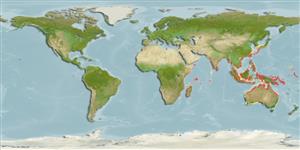>
Siluriformes (Catfishes) >
Ariidae (Sea catfishes) > Ariinae
Etymology: Arius: Greek, arios, areios = dealing with Mars, warlike, bellicose (Ref. 45335).
More on author: Hamilton.
Environment: milieu / climate zone / rango de profundidad / distribution range
Ecología
marino; salobre demersal; anfidromo (Ref. 51243). Tropical
Indo-West Pacific: India through neighboring coastal states (Pakistan, India, Bangladesh and Myanmar, Ref. 4833) to Singapore, South China Sea.
Tamaño / Peso / Age
Madurez: Lm ? range ? - ? cm
Max length : 40.0 cm SL macho / no sexado; (Ref. 38478); common length : 15.0 cm SL macho / no sexado; (Ref. 4833)
Espinas dorsales (total) : 1; Radios blandos anales: 17 - 22. Head shield smooth anteriorly with a series of granules and rugae posteriorly. Adipose fin with a large black spot. Lateral line bifurcating at the base of tail. Gill rakers present on the hind aspect of all gill arches. Dorsal spine with a filament at its tip. Moderately deep caudal peduncle, 1.5 to 2.1 (mean 1.8) in its depth. (Ref. 38478).
Body shape (shape guide): elongated.
Common in estuaries, tidal rivers and brackish water lakes. Feeds mostly on invertebrates. Caught mainly with bagnets, dipnets and bamboo stake traps, also on hook and line (Ref. 3290).
Life cycle and mating behavior
Madurez | Reproducción | Puesta | Huevos | Fecundidad | Larva
Kailola, P.J., 1999. Ariidae (=Tachysuridae): sea catfishes (fork-tailed catfishes). p. 1827-1879. In K.E. Carpenter and V.H. Niem (eds.) FAO species identification guide for fishery purposes. The living marine resources of the Western Central Pacific. Vol. 3. Batoid fishes, chimaeras and bony fishes part 1 (Elopidae to Linophrynidae). FAO, Rome. (Ref. 38478)
IUCN Red List Status (Ref. 130435: Version 2025-1)
Threat to humans
Traumatogenic (Ref. 58010)
Human uses
Pesquerías: comercial
Herramientas
Special reports
Download XML
Fuentes de Internet
Estimates based on models
Preferred temperature (Referencia
123201): 24.9 - 29.2, mean 28.5 °C (based on 2376 cells).
Phylogenetic diversity index (Referencia
82804): PD
50 = 0.5000 [Uniqueness, from 0.5 = low to 2.0 = high].
Bayesian length-weight: a=0.00550 (0.00351 - 0.00860), b=3.14 (3.01 - 3.27), in cm total length, based on LWR estimates for this species & (Sub)family-body (Ref.
93245).
Nivel trófico (Referencia
69278): 3.5 ±0.37 se; based on food items.
Resiliencia (Referencia
120179): Medio, población duplicada en un tiempo mínimo de 1.4-4.4 años (Preliminary K or Fecundity.).
Fishing Vulnerability (Ref.
59153): Moderate vulnerability (39 of 100).
🛈
